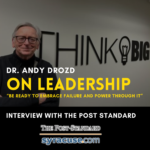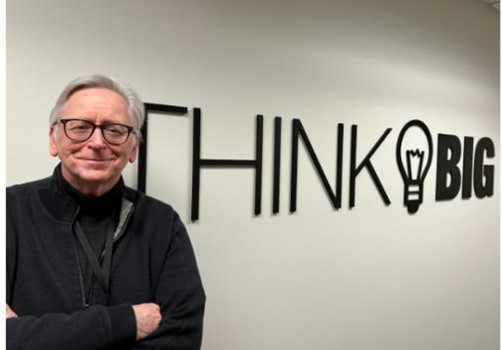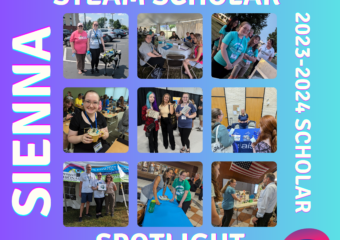A childhood love of science fiction led Andrew L. Drozd, Ph.D., to a love of science.
Drozd is president and CEO of Andro Computational Solutions LLC, a tech company headquartered at the Griffiss Business & Technology Park, in Rome.
Drozd (rhymes with rose) grew up in Rome and turned an early-career interest in communications into a tech company that innovates at the intersection of artificial intelligence and wireless telecommunications technology. He worked for General Electric and other companies before striking out on his own 30 years ago.
“We solve some of the most difficult problems in radio spectrum management and radio frequency communications for the Defense Department and commercial clients,” Drozd says. He says Andro is the first in the world to solve a complex problem of updating communications hardware via software.
Andro recently shared the award for STEM project of the year from the Technology Alliance of Central New York.
Another tough problem is raising the skills of young people to fill tech and manufacturing jobs in the Mohawk Valley. A decade ago, Drozd and a group of fellow businesspeople started the Project Fibonacci Foundation for STEAM Education. It’s named for a numerical sequence that occurs in nature and the cosmos, and also in music, design and mathematics. The foundation conducts immersive programs in schools and conducts a yearly conference, at which young people are tasked to solve a difficult problem using critical thinking skills. Drozd believes including the arts in science, technology, engineering and math education brings an essential dimension to problem-solving.
Andro employs about 50 people and is growing, with offices in Rome, Syracuse, San Diego, Washington, D.C., and Dayton, Ohio.
Drozd is in his mid-60s and lives in his hometown of Rome with his wife, Barb. Their son, Evan, works for a division of Andro. Our conversation has been edited for length and clarity.
Tell me a bit about your journey to becoming a scientist.
I’ve always been a bit of a geek when it came to science. I would watch “The Twilight Zone” and “The Outer Limits.” They piqued my interest in space, space travel, even aliens. As I got a little older, I got more into things like “Star Trek.” And that really piqued my interest because now I could see all the technology that has to be built to travel to space.
I had an affinity for science in high school [at the former Rome Catholic] and had inspiring teachers who challenged me. I saw the relationship between science and mathematics, which always intrigued me.
[At my first job at the Rome Air Development Center, now known as Rome Labs] I got into drafting. That was when I started realizing there’s this correlation between science and art, style and perspective. It expanded my way of thinking. And that today is why I look at things in terms of a STEAM model, a STEM plus arts model.
Were you in leadership roles growing up? Who and what influenced you in developing your leadership abilities?
I was not exposed to any standout leadership pursuits or opportunities during my formative years that I can recall. … My professional leadership role happened early in my career. Barely one year into my full-time career, I had to step in to take the reins on a project that was being managed in a less than effective way. That opportunity put me on a course for roles as a technology leader and program manager early on.
There’s one professor in particular who really molded me, [the late] Dr. Don Weiner. He was a Syracuse University emeritus professor. He instilled in me the value, the meaning, the purpose of what you do. And he always taught me: If you fail, get up, keep working at it, continue on. I learned a lot about embracing failure, doing better, improving, refining and getting the reward out of that. He was a very important aspect of my growing up.
You’ve been using artificial intelligence for a while. The rest of us are just catching up to it. Should we be afraid of it?
Yes and no. AI brings advantages as well as risks.
For every intended good use of AI comes the potential for bad actors and unscrupulous intent. Hence, the need for guard rails or what I call “kill switches” to put humans on the loop rather than in the loop.
… A good use of AI is in its ability to rapidly detect cancer or tumors, for example. Will that eliminate doctors? No, I don’t think it will. Will it eliminate the physician assistants? Possibly. It’s transforming the landscape of the job markets and job opportunities, good and bad.
Where it is dangerous is the tried-and-true concerns with misinformation, disinformation, deep fakes. Foreign countries and domestic actors are just sending out stuff and adulterating what we should know.
We’re already looking at how AI machines will battle each other. Not like robots, but computers that are trying to fight for a certain kind of a goal. It’s based on this concept of game theory. … As you make those things smarter and tougher and more durable over time, it’s going to be difficult to defeat. If the enemy, so to speak, gets a hold of this kind of concept, we’re in trouble. That’s the downside.
What do you wish you’d known about running a company before you started?
Dealing with Department of Defense and federal budgets… As you’re developing your business, you’re synchronizing it with the cycle of the budgets because sometimes the federal budget has a drastic drop, depending on the administration or other factors. The funding isn’t there, and now you’re stuck running a business with X number of people. What do you do?
Andro is a very durable company. We survived through about three phases of these downturns, and we got through it and got stronger each time. But I wish someone had mentored me about what to watch out for, because I learned it the hard way.
How can a leader spark innovation in an organization?
Creating opportunities to address urgent needs challenges. I inspire our workforce and research teams to put themselves in the role of the warfighter or the first responder. What can we do to develop innovative solutions and better products that can be used to defend our troops who are in harm’s way and save lives and property? The same extends to the world of first response and emergency management. Keep pushing the edge of the envelope to make a difference that benefits society and is purposeful and meaningful.
… You just can’t cut corners because that’s going to affect somebody later. If we don’t address a particular corner case or an edge case in a problem, then that could cost lives. I instilled this kind of thinking in all [of my employees].
I also espouse the philosophy of intra- and entrepreneurism — take the bull by the horn and push things to the limit until there is none.
What’s an intrapreneur?
Someone who basically takes entrepreneurial frames of thought and brings them into the company on internal projects. An example would be where a budding program manager will start thinking about developing their own path forward, professional development, and eventually maybe they’ll start their own company. I’m OK with that. I don’t want to lose that talent. But if I can cultivate it for a period of time and maybe look at spinning that off, making, putting them in charge, then I think that’s a great thing.
What advice would you give for effective leadership, especially for a new leader or for someone aspiring to take on leadership responsibilities?
The biggest piece of advice is an old adage: Be ready to embrace failure and power through it, and be agile and adaptable, and stay cool but be upfront with your clients and workforce.
A fixed mindset or frame of thought is not going to get you very far. The technology that we have today especially is advancing at such a rapid pace that the degrees that I got [in physics and math] provided a wonderful foundation. But in terms of the technology today, they’re almost irrelevant.
What’s the best advice a parent, mentor or boss ever gave you?
Failure is the best teacher. It sounds trite, but it’s really true. You learn so much from the mistakes you make, and you just regroup and make it better. You have to be persistent, too.
When I was a young lad, I was also a bit rambunctious and one of my teachers also told me I likely wouldn’t amount to anything. I had to prove that teacher wrong and it was a great lesson in applying reverse psychology.
If you could go back in time, what would you tell your younger self?
Get ready for a wild ride! It won’t be easy, but the rewards are immense if you stay the course.
Tell me about the genesis of the Project Fibonacci Foundation and what you hope to accomplish with it.
Leonardo Pisano (Fib)Bonacci was a 13th century Italian mathematician who by observing nature, identified a mathematical structure that was repeated across multiple domains of nature, art, science and engineering. His discoveries led to the Golden Ratio that is found in the geometry of the Great Pyramids to the shape of astronomical bodies. He is our namesake for the foundation.
The short story is that local CEOs in the Mohawk Valley met to discuss ways we could try to stimulate interest in families relocating to our area and expand the job base in tech and manufacturing fields. That inspired me to launch a foundation that tapped into a rich STEM + Arts or STEAM mindset that emphasizes leadership education and using the arts to grow the STEM workforce.
… It’s not just art. We’ve got to find the science and the math behind the art. There are nuances there I think we could bring out that would help students understand why this is important, why they’re all interconnected, and we have to break the silos on domains.
.. Now you start engaging different talents to solve complex problems. And that was the core of it. We wanted to use the arts to grow the STEM workforce by solving complex techno socio technological problem sets in the world today, like climate change or the emergence of AI.
What needs to happen to prepare the region’s work force for the arrival of Micron and associated companies?
Create inspiring and aspirational STEAM programs that entice the youth of our area to stay and take jobs with Micron and/or to launch their own startups. We need to create opportunity and shine a light on workforce preparedness pathways that highlight the value of local industries and programs that can help lead them there and that revitalize our communities. Also, focus on expanding the net to encompass those who are underrepresented or underserved, including females in STEM.
How would you sell CNY and the Mohawk Valley to someone who may want to relocate here for job opportunities?
We’re trying to create opportunities for people here, whether it be in scientific research, what we do here in Andro, or looking at colleges, universities, and other opportunities under the Project Fibonacci approach. They come together, obviously, because we’re a STEM company and that’s a STEAM program, but I think just creating opportunity, making people aware, reaching out to people to come back here where we can.
… You may spend the first five, 10 years of your career here. You may want to spin off or move on or do other things. And we accept that, you know, whenever it makes sense, but we need to help create that pathway.
In the News:





